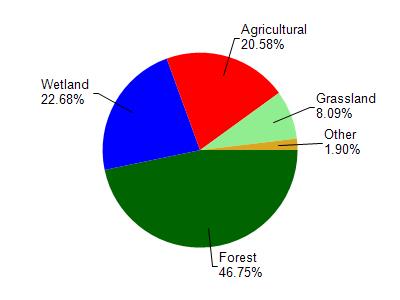Portage
No
No
No
Fish and Aquatic Life
Overview
Tree Lake, in the Upper Little Wolf River Watershed, is a 73.24 acre lake that falls in Portage County. This lake is managed for fishing and swimming and is currently considered impaired.
Date 2015
Author Aquatic Biologist
Historical Description
Source: 1972, Surface Water Resources of Portage County Tree (Three) Lake, T25N, R10E, Section 3, Surface Acres-71.3, S.D.F.-1.22, Maximum Depth-34 feet.
Tree Lake is a clear, hard water drainage lake four miles north of Rosholt. It has two inlets. The smaller of the two enters on the northwest side and is the outlet from Mud Lake. The second, Klondike Creek, supplies a good flow of cold water and is also a fine brook trout stream. The outlet flows into the North Branch of the Little Wolf River. The lake develops a midsummer decline at about ten feet. The littoral bottom materials consist of sand, gravel, and silt. Common fish species include northern pike, perch (which are stunted), largemouth bass, bluegill, black crappie, and white sucker. Walleye, pumpkinseed, yellow bullhead, brook trout (probably from Klondike Creek), and forage species are also present. The heaviest wildlife use of the lake is by migrating waterfowl, including both dabbling and diving ducks. Public access is available via Peterson Park on the northeast shore. Facilities include a picnic area, beach, change house, toilets, drinking, water, boat launching ramp, and plenty of parking room. Swimming, fishing, boating, and water skiing, are the main attractions of this lake. Private developments consist of 38 cottages and homes, one resort, and one boat rental. The north side of the lake is the most heavily developed.
Date 1972
Author Surface Water Inventory Of Wisconsin
Impaired Waters
Tree Lake (WBIC 289400) was placed on the impaired waters list for excess algal growth in 2014. The 2018 assessments showed continued excess algal growth; new chlorophyll-a sample data exceeded the 2018 WisCALM listing thresholds for the Recreation use. Total phosphorus data were clearly below the Recreation use and Fish and Aquatic Life use listing thresholds. Based on the most updated information, no change in the existing impaired waters listing was needed.
Date 2017
Author Ashley Beranek
Impaired Waters
Tree Lake (289400) was placed on the impaired waters list for excess algal growth in 2014. The 2016 assessments showed continued excess algal growth; chlorophyll sample data exceed 2016 WisCALM listing thresholds for the Recreation use, however, total phosphorus were clearly below REC thresholds. Total phosphorus and chlorophyll data were clearly below Fish and Aquatic Life listing thresholds. Based on the most updated information, no change in existing impaired waters listing is needed.
Date 2015
Author Aaron Larson
Condition
Wisconsin has over 84,000 miles of streams, 15,000 lakes and milllions of acres of wetlands. Assessing the condition of this vast amount of water is challenging. The state's water monitoring program uses a media-based, cross-program approach to analyze water condition. An updated monitoring strategy (2015-2020) is now available. Compliance with Clean Water Act fishable, swimmable standards are located in the Executive Summary of Water Condition in 2018. See also the 'monitoring and projects' tab.
Reports
Management Goals
Wisconsin's Water Quality Standards provide qualitative and quantitative goals for waters that are protective of Fishable, Swimmable conditions [Learn more]. Waters that do not meet water quality standards are considered impaired and restoration actions are planned and carried out until the water is once again fishable and swimmable
Management goals can include creation or implementation of a Total Maximum Daily Load analysis, a Nine Key Element Plan, or other restoration work, education and outreach and more. If specific recommendations exist for this water, they will be displayed below online.
Monitoring
Monitoring the condition of a river, stream, or lake includes gathering physical, chemical, biological, and habitat data. Comprehensive studies often gather all these parameters in great detail, while lighter assessment events will involve sampling physical, chemical and biological data such as macroinvertebrates. Aquatic macroinvertebrates and fish communities integrate watershed or catchment condition, providing great insight into overall ecosystem health. Chemical and habitat parameters tell researchers more about human induced problems including contaminated runoff, point source dischargers, or habitat issues that foster or limit the potential of aquatic communities to thrive in a given area. Wisconsin's Water Monitoring Strategy was recenty updated.
Grants and Management Projects
Monitoring Projects
| WBIC | Official Waterbody Name | Station ID | Station Name | Earliest Fieldwork Date | Latest Fieldwork Date | View Station | View Data |
|---|
| 289400 | Tree Lake | 503135 | Tree Lake - Deepest Spot | 5/28/1990 | 9/24/2025 | Map | Data |
| 289400 | Tree Lake | 10005133 | Tree Lake | 7/27/1999 | 3/10/2024 | Map | Data |
| 289400 | Tree Lake | 10017488 | Tree Lake -- Access | 7/9/2008 | 6/5/2021 | Map | Data |
| 289400 | Tree Lake | 10017489 | Tree Lake -- Access | 7/26/2009 | 6/24/2012 | Map | Data |
| 289400 | Tree Lake | 10054144 | Peterson Park Beach on Tree Lake | 5/21/2019 | 8/23/2023 | Map | Data |
|

Watershed Characteristics
Tree Lake is located in the Upper Little Wolf River watershed which is 182.05 mi². Land use in the watershed is primarily forest (46.80%), wetland (22.70%) and a mix of agricultural (20.60%) and other uses (10.00%). This watershed has 160.69 stream miles, 841.95 lake acres and 26,786.17 wetland acres.
Nonpoint Source Characteristics
This watershed is ranked Medium for runoff impacts on streams, Not Ranked for runoff impacts on lakes and High for runoff impacts on groundwater and therefore has an overall rank of High. This value can be used in ranking the watershed or individual waterbodies for grant funding under state and county programs.However, all waters are affected by diffuse pollutant sources regardless of initial water quality. Applications for specific runoff projects under state or county grant programs may be pursued. For more information, go to surface water program grants.